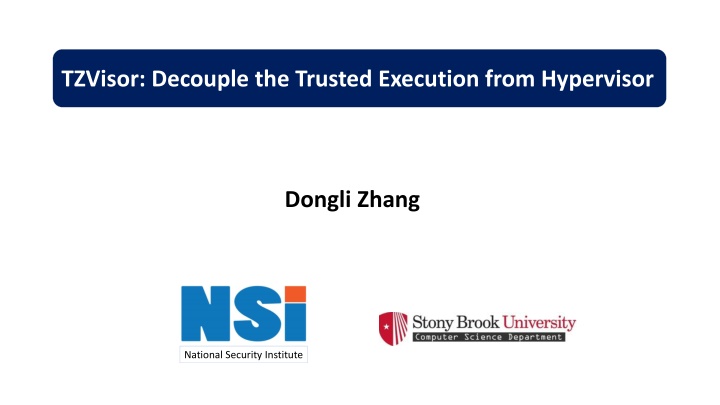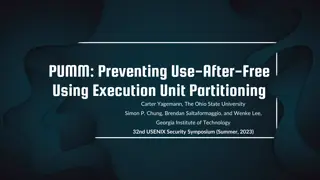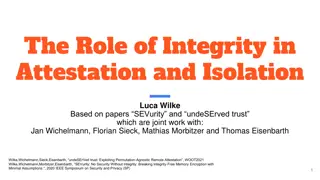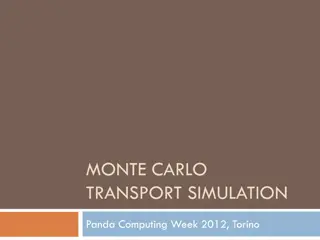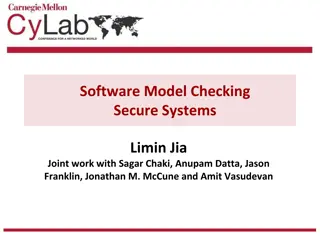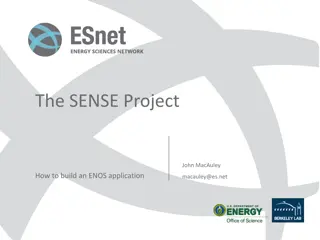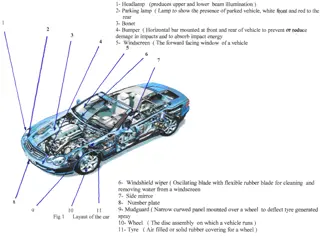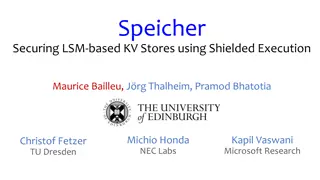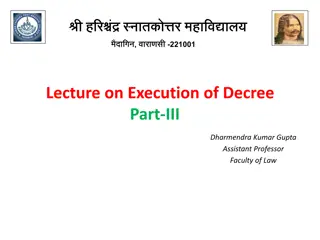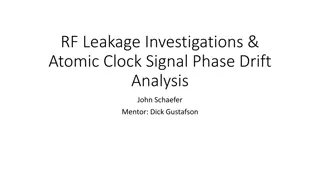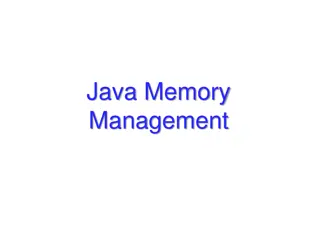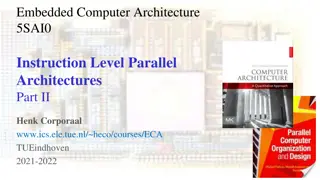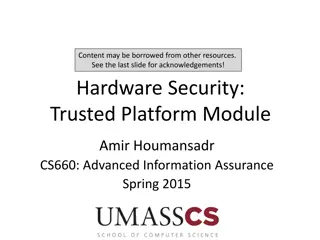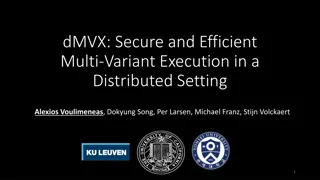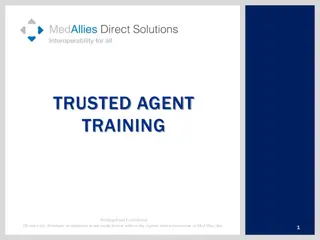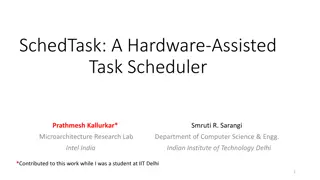TZVisor: Decouple the Trusted Execution from Hypervisor
Delve into the innovative concept of TZVisor and its impact on improving security by decoupling trusted execution from hypervisors, as discussed in a presentation by Dongli Zhang at the National Security Institute. Explore the objectives, challenges, and solutions related to this cutting-edge technology in virtualization and infrastructure management, highlighting the crucial role of security-sensitive block processing and TrustVisor. Discover the state-of-the-art solutions and research works contributing to advancements in trusted hardware and hypervisor technologies.
Download Presentation

Please find below an Image/Link to download the presentation.
The content on the website is provided AS IS for your information and personal use only. It may not be sold, licensed, or shared on other websites without obtaining consent from the author.If you encounter any issues during the download, it is possible that the publisher has removed the file from their server.
You are allowed to download the files provided on this website for personal or commercial use, subject to the condition that they are used lawfully. All files are the property of their respective owners.
The content on the website is provided AS IS for your information and personal use only. It may not be sold, licensed, or shared on other websites without obtaining consent from the author.
E N D
Presentation Transcript
TZVisor: Decouple the Trusted Execution from Hypervisor Dongli Zhang National Security Institute
Objective of Talk Idea of TZVisor Flow of the presentation Confusion Design Problem Weakness ARM Virtualization and Security Extensions Stony Brook Network Security and Applied Cryptography Laboratory TZVisor 2015 February 22, 2025 2 National Security Institute
Infrastructure as a Service (IaaS) Virtualization IaaS Applications VM (OS) VM (OS) You manage Data, Runtime, Middleware OS Virtualization (Hypervisor) Virtualization Storage Others manage Physical Machine Networking Stony Brook Network Security and Applied Cryptography Laboratory TZVisor 2015 February 22, 2025 3 National Security Institute
Security Sensitive Block password Processing Password SSH Service Security Sensitive Remote User VM (Guest OS Kernel) Vulnerable Service Application Vulnerable (or Malicious) Guest OS Kernel Vulnerable Hypervisor Malicious Cloud Administrator Hypervisor (KVM, Xen) Cloud Stony Brook Network Security and Applied Cryptography Laboratory TZVisor 2015 February 22, 2025 4 National Security Institute
TrustVisor (S&P 2012) Security Sensitive Code as PAL (Pieces of Application Logic) Tiny hypervisor for isolation of code PAL (S) Hardware memory virtualization Privacy & Integrity No scheduling or Inter-Process Communication Software-emulated TPM and Hardware TPM TCB = Trusted Hardware + TrustVisor Limitations Cannot support multiple VMs No scheduling of PAL Small TCB = Less Functionality App App Untrusted S Trusted OS V TrustVisor white Attestable HW Stony Brook Network Security and Applied Cryptography Laboratory TZVisor 2015 February 22, 2025 5 National Security Institute
State of the Art Solution Research Works Trusted Hardware Flicker (EuroSys 2008), TrustVisor (S&P 10) Hypervisor OverShadow (ASPLOS 08), InkTag (ASPLOS 13), TrustVisor (S&P 10), CloudTerminal (ATC 12) SFI VirtualGhost (ASPLOS 14) Stony Brook Network Security and Applied Cryptography Laboratory TZVisor 2015 February 22, 2025 6 National Security Institute
ARM vs. x86 ARMv7 (32-bit) -> ARMv8 (64-bit) Marvel s ARM chipse tin Baidu s server in 2013 AMD Cortex-A57 server platform for developers in 2014 Qualcomm joined ARM server chip business in 2014 Lenovo's ARM-based NextScale in 2015 Stony Brook Network Security and Applied Cryptography Laboratory TZVisor 2015 February 22, 2025 7 National Security Institute
ARM Hardware Virtualization KVM/ARM: The Design and Implementation of the Linux ARM Hypervisor. ASPLOS 14 ARM Fast Models (ARMv7 32-bit) ARM Foundation Model (ARMv8 64-bit) Arndale Board with Samsung Exynos 5250 Chromebook with Samsung Exynos5250 Omap5, VExpress, Cubieboard Xen on ARM ARM Fast Models (ARMv7 32-bit) ARM Foundation Model (ARMv8 64-bit) Arndale Board with Samsung Exynos 5250 Chromebook with Samsung Exynos5250 Cubieboard non-root mode (guest) PL1 mode (kernel, svc) root mode (host) PL2 mode (hyp) x86 HV ARM HV Stony Brook Network Security and Applied Cryptography Laboratory TZVisor 2015 February 22, 2025 8 National Security Institute
Limitations of Using Hypervisor Vulnerable hypervisor (KVM, Xen), CVE-2007-4993 Large Trusted Code Base (TCB) Large Trusted Employee Base (TEB) Complex hypervisor code modification Ease of porting (w/ or w/o hypervisor) Trusted Untrusted Hypervisor VM VM Admin Stony Brook Network Security and Applied Cryptography Laboratory TZVisor 2015 February 22, 2025 9 National Security Institute
ARM TrustZone ARM Security Extension Secure World & Normal World Memory Region Peripherals DMA Protection Interrupt Isolation Security-aware Debug State of the Art Trusted Sensors (MobiSys 12) TLR (ASPLOS 14) VeriUI (HotMobile 14) TrustUI (APSys 14) TrustDump (ESORICS 14) SPROBES (Most 14) TZ-RKP (CCS 14) SeCReT (NDSS 15) Stony Brook Network Security and Applied Cryptography Laboratory TZVisor 2015 February 22, 2025 10 National Security Institute
TZVisor Objective Minimized Trusted Code Base (TCB) Decouple TEE from hypervisor Minimized Trusted Employee Base (TEB) Multiplexing Secure World - IaaS (Multi-Tenant) vs. Smartphone Two-Level Isolation Tiny Fair Scheduling Remote Attestation Stony Brook Network Security and Applied Cryptography Laboratory TZVisor 2015 February 22, 2025 11 National Security Institute
TZVisor Design Secure World Normal World Application PAL PAL LKM Agent Agent VM (Linux Kernel) LKM Secure Tiny Kernel (STK) KVM Stony Brook Network Security and Applied Cryptography Laboratory TZVisor 2015 February 22, 2025 12 National Security Institute
Trust Model Entity Work Trust Not Trust Remote Client (optional) IaaS User Use service in IaaS VM s application Deploy VM kernel and applications Administrate IaaS, including hypervisors (Normal World) Secure Service Provider Secure Service Provider Secure Service Provider IaaS User, IaaS Admin Remote Client, IaaS Administrator Remote Client, IaaS User IaaS Admin Secure Service Provider Install STK (Secure World) N/A Remote Client, IaaS User, IaaS Administrator Stony Brook Network Security and Applied Cryptography Laboratory TZVisor 2015 February 22, 2025 13 National Security Institute
ARM Memory Domain Segmentation in ARM (MMU enabled) Domain Access Control Register (DACR) 16 domains 4-bit domain ID in 1st-level page table entry Stony Brook Network Security and Applied Cryptography Laboratory TZVisor 2015 February 22, 2025 14 National Security Institute
Two-Level Isolation Minimize Secure Tiny Kernel Leverage non-kernel function to user STK Agent PAL DACR_DOM1 & DACR_DOM2 0x00000000 Pieces of Application Logic (PAL) 128MB 0x08000000 Dom 1 Data Buffer 64MB 0x0c000000 Agent (Forwarder & TPM, etc) Dom 2 64MB 0x10000000 User DACR_DOM1 DACR_DOM2 0xc0000000 Kernel Domain Access Control Register (DACR) Secure Tiny Kernel (STK) Stony Brook Network Security and Applied Cryptography Laboratory TZVisor 2015 February 22, 2025 15 National Security Institute
Scheduling 1 Secure World Normal World Running! PAL PAL Application LKM Agent Agent VM (Linux Kernel) LKM Secure Tiny Kernel (STK) KVM Schedule Scheduling Decision Context Switch Timer Stony Brook Network Security and Applied Cryptography Laboratory TZVisor 2015 February 22, 2025 16 National Security Institute
Scheduling 2 nonblocking call again: call vm_call_pal if finish return else if not finish go to again end if TrustZone Secure World Secure Tiny Kernel (STK) Stony Brook Network Security and Applied Cryptography Laboratory TZVisor 2015 February 22, 2025 17 National Security Institute
PAL Life Cycle PAL Registration PAL Invocation PAL Unregistration PAL TPM Operations KVM Module libtzsec VM Module libtznorm Stony Brook Network Security and Applied Cryptography Laboratory TZVisor 2015 February 22, 2025 18 National Security Institute
Secure Boot Only signed (private key) image can boot the ARM board Private key is confidential to regular IaaS administrators Boot ROM does integrity check of the first image (secure world) Secure World Normal World Verify and boot boot boot Secure Tiny Kernel (STK) Boot ROM Hypervisor VM OS Manufacturer IaaS User Core Admin or Manufacturer Hyp Admin Stony Brook Network Security and Applied Cryptography Laboratory TZVisor 2015 February 22, 2025 19 National Security Institute
Implementation Platforms (32-bit) ARM Fast Models 9.1 Cortex-A15x1 Samsung Exynos 5250 Arndale Board Cortex-A15x2 Secure World Boot-wrapper (Fast Models) U-Boot(Arndale Board) xv6-armv7 < 10k LOC Normal World Linux 3.14 (Guest and Host) KVM Module, VM Module libtzvsec, libtzvnorm Port SSH Stony Brook Network Security and Applied Cryptography Laboratory TZVisor 2015 February 22, 2025 20 National Security Institute
Limitation ARMv7 (32-bit) vs. ARMv8 (64-bit) TZASC Performance Overhead TZASC on DDR channel TZASC is under NDA [Freescale i.MX6DQ Reference Manual]: Enabling TZASCs is expected to have a slight impact on memory performance. Exact value cannot be stated, since varies, depending on specific application software. Secure Boot is under NDA DOS Attack Secure Channel between Application and PAL (SeCReT, NDSS 15) Limited functionality in PAL Stony Brook Network Security and Applied Cryptography Laboratory TZVisor 2015 February 22, 2025 21 National Security Institute
Evaluation Lines of Code (LOC) TCB Size = STK LOC modified in KVM (and Xen) Total LOC (modules, libraries) Microbenchmarks Macrobenchmarks Porting Effort Stony Brook Network Security and Applied Cryptography Laboratory TZVisor 2015 February 22, 2025 22 National Security Institute
Preliminary Data Freescale i.MX53 Quick Start Board i.MX53 1 GHz ARM Cortex-A8 Processor 1GB DDR3 memory Normal World Linux 2.6.35 (ARMv7) Secure World Bare-metal code Instruction cached disabled Data cached disable MMU disabled Stony Brook Network Security and Applied Cryptography Laboratory TZVisor 2015 February 22, 2025 23 National Security Institute
Summary First ARM based trusted execution framework (KVM, Xen) in IaaS (with evaluation) Scheduling & Two-Level Isolation Remote Attestation Trusted execution management is decoupled from hypervisor Hypervisor is decoupled from TCB Trusted Employee Base (TEB) is minimized Trusted Untrusted Secure Tiny Kernel Hypervisor VM Core Admin Hyp Admin Stony Brook Network Security and Applied Cryptography Laboratory TZVisor 2015 February 22, 2025 24 National Security Institute
